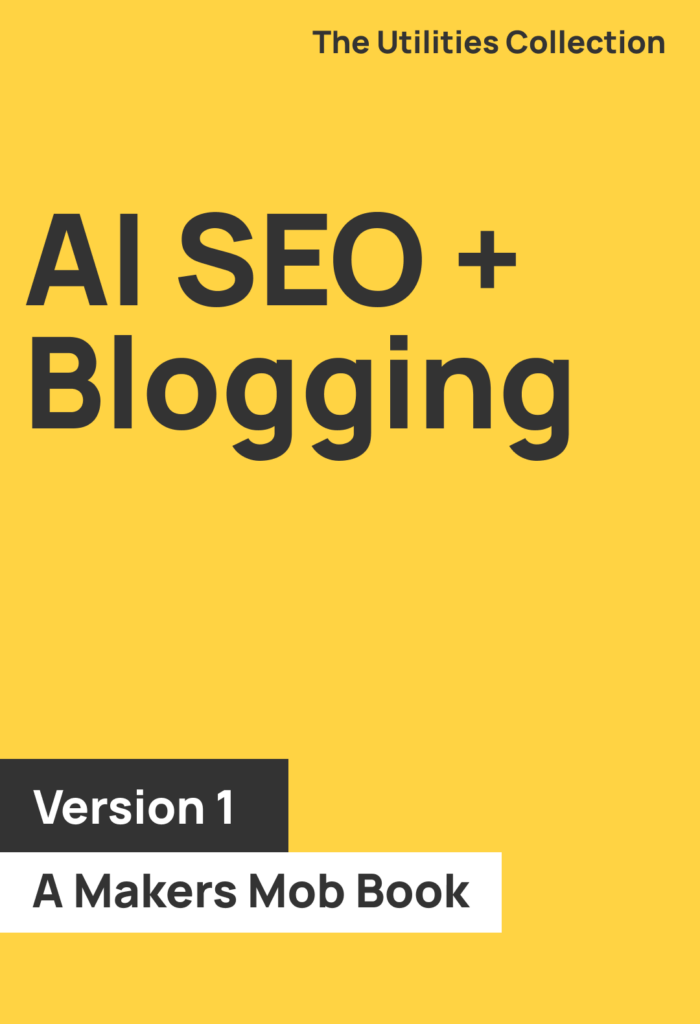I bet this happens to you, too. On your to-do list is “Write a post”.
And so you look at the list and you’re like, “Excellent. Let’s sit down and get this thing done!”
And then, depending on how prepared you are for writing a post, it may take you three days to write that post or it may take you 2 hours.
If it ends up taking three days then you will likely quickly start to not like writing posts so much. They seem so time-consuming!
But, if it takes you just a few hours, you will enjoy it and you’ll feel that great sense of accomplishment at having DONE something for your business.
To get to that place of being able to write a post in just a few hours, you need to be prepared and you need to understand what “writing a blog post” really means.
A blog writing checklist will help you be prepared and I’ve got one for you, but first, let’s talk about what “writing a blog post” really means.

This is What Is Included in Writing a Blog Post
I have a problem with getting overwhelmed easily when tasks take many steps to complete. I’ve found the best way to overcome that feeling of overwhelm is to break things down into specific categories of tasks.
That is very simple to do when it comes to writing a blog post.
I include two tasks in the writing a blog post category. I write the post and edit it after I’m done.
That’s it.
Is that all you need to do to write a blog post? Most definitely not!
And that’s where the overwhelm comes in. To be able to sit down and just write and edit you have to be prepared ahead of time. There are a bunch of things that come before and after the writing and the editing are done in order to have a really solid blog post.
So, I’ve built a before, during, and after blog writing checklist for myself that helps me keep perspective on what I really need to focus on at each stage of the blog post process.
And here’s my secret tip for you.
I’ve timed myself doing some of the before and after steps. Knowing approximately how long it takes to complete those steps means your brain can’t go, UGHHHHH we don’t have time for this.
If it only takes 15 minutes to find and add images to your post and you just happen to have 20 minutes, then, guess what? You do have time.
Time yourself doing some of the things on the list and see if you aren’t surprised at what you can accomplish with a relatively small chunk of time.

Blog Writing Checklist – Before the Writing
I worked out this list at some moment of panic where I just felt completely overwhelmed by writing an entire post in a short period of time with a deadline to be met.
Until now, it has always just lived in my brain. I’m releasing the blog writing checklist from my brain, officially, so that it may help others.
We’re going to start with what you need to be doing before you think about sitting down to write so that when you do sit down to write, all you’re doing is writing and editing.
#1. Keyword Research
Before you think about writing a post, you should be doing keyword research. In fact, you should be doing keyword research WAY before you think about writing a post.
Ideally, your keyword research should be done as a completely separate task from writing so that when you do sit down to write, you’ve got a list of keywords that you can take a quick look at and choose which one to write about.
Trying to figure out keywords that work for a post should not be part of the writing process. Sometimes it takes a super short time to find the right keyword (keywords, really, when you add in the long tail ones you want to include) and sometimes it’s a task you can get stuck on.
You don’t want to be “stuck” when you’re supposed to be in writing mode. You want to just write.
So, if you haven’t already, set aside some time this week to get cozy with a spreadsheet and spend 30 minutes finding 30 keywords you can write about.

#2. Topic Research
There are two types of posts. There are posts you can just write off the top of your head (like how I’m writing this one) and there are posts that you need to sit down and do some research on.
When you aren’t separating the idea of “researching your topic” from “writing” then it can become very easy to choose to write about topics that you don’t have to do research on.
If you want to get a post written, then writing off the top of your head sounds like the quick, easy way to get the writing done. And it’s totally fine to do that from time to time if you really know your topic well and you can write a solid, valuable post from your head.
But you do have to be careful of falling into the trap of only writing off the top of your head. Often it’s when you are doing research for posts that you start to learn new things about your niche.
And you should always be learning.
I admit I usually do my research just before writing. It works for me, but it’s a really smart idea to set aside time every week just for research.
Make notes and maybe even outline a post while you’re doing it so that you are really ready to jump into writing when the writing time comes.
Blog Writing Checklist – The Writing & Editing
You’ve got your keyword and you’ve done your research. It’s kind of like when you stayed up an extra few minutes to do the dishes at night and then you wake up in the morning and you’re like, OH MY LIFE IS SO MUCH BETTER NOW.
I hope you know what that feeling is like.

#1. Write
This is pretty straightforward. I usually start my writing with a super simple outline. It looks like this when I start:
So, seriously, really simple. But sometimes even when I’ve got my keyword research done and I have my topic research done, I still get a little frozen by the blank page and flashing cursor.
Just the act of putting together that quick outline gets me moving.
And then I write. I’ll tell you at the end of this post how long just the writing itself took, OK? Sometimes it’s a couple of hours, sometimes it’s 3 or more.
There are still posts that take days. Those long and detailed posts do take a lot of time. But I break those up into chunks as if each large section is almost a post itself (this what is copywriting post is one of those. It’s still not done, but I sit down and write new sections for it periodically).
The only thing you might want to add to this phase of the blog writing checklist is a mood setter for writing.
I really want to be a person who lights a candle or puts on a particular playlist when she sits down to write because I do think that setting that writing mood is a good idea. It becomes part of the ritual.

#2. Editing
Everybody on the planet is going to tell you to just write and don’t edit as you go.
I say no.
What I mean by that is, don’t worry about typos or grammar or whatever. Don’t worry about adding links or any of that stuff.
But, I do break that cardinal writing rule of “Don’t edit while you write” pretty much every time I write a post.
I find that there are times while I’m writing that going back and re-reading what I just wrote and making it clearer helps me clarify things in my own brain so that I stay on track with the rest of the writing.
So, feel free to edit for clarity while you are writing.
Then immediately after writing, do your closer inspection editing. Look for typos, grammar, and all that stuff. I usually add any internal links at this point, too, just because that’s a simple enough thing to do.

Blog Writing Checklist – After the Writing & Editing
When you choose to do these things is up to you. If you’ve finished writing and you have some extra time to bang out these kinds of mundane tasks, then do it immediately after writing.
If you don’t do them immediately after writing, make sure you set aside time to go back and do them. Your “Post” is not done until these things are done.
You might have finished “writing”, but that doesn’t mean the post is ready for the world.
#1. Images
Images are a very important part of the blog writing checklist.
Images are good for the reader experience and reader experience is extremely important to the success of your blog.
If a reader comes to your site and scans through and feels overwhelmed by the amount of text, then they may not read through entirely, or they may just leave.
Images help to break up those walls of text that can be overwhelming. They offer a little rest for your reader.
They also help your SEO. For each image you add, you have an opportunity to add a keyword into the alt text and that’s always a good thing.
While there is nothing wrong with using stock photos there comes a time when every stock photo feels like it’s being used on another blog already. The alternative of creating your own can be time-consuming and expensive.
So what can you do?
You can turn to Midjourney to create your blog images. It’s what we use for the majority of images that you see across this site and you can create anything that you want.
It’s well worth the small investment.
#2. SEO Check
You took the time to do all of that keyword research, make sure that your post is optimized so that you can rank for it!
There are lots of great SEO tools that can help with this. We are using Rank Math currently and have used Yoast in the past.
Rank Math, I have to say, is a pretty amazing tool to work with for making sure you’ve covered all of your bases when it comes to on-page SEO.
Don’t forget to review your blog post title during this step!

#3. Review for Readability
The very last thing I like to do before I hit the publish button on a post is to look at it in preview and see where there are spots where I can improve the reader experience.
I’ve already added my images, so that should break up most of the “walls of text”.
In this final check, I’m looking for places where I can add some bolded text, maybe a numbered or bulleted list or any paragraphs that I can break up that might have gotten a little too long.
It’s taken a long time to break the habit of writing monster paragraphs!
#4. Send the post out into the world.
You’ve done all of this hard work, you’ve hit publish, now make sure you let people know about it!
I don’t usually do this immediately after hitting publish. I set time aside during the week to make pins for Pinterest and I think it’s a good idea to keep this promotion part of the process very separate from the writing part.
I think this is a good idea because I don’t really enjoy the promotion part and if in my head the last part of the process of writing a post is “make social media graphics”, I am never going to be excited to write a post!
So do this whenever you see fit. I usually do it 2-3 times a week, but never immediately after writing a post.
And That’s the Whole Blog Writing Checklist
Breaking things down in this way puts “writing a post” into perspective.
It’s funny when I read back through this post, it reminds me that my life kind of turned out exactly as I would have expected if I had known that blogging was a thing way back when I was a young adult.
I knew I loved writing, but not fiction and I love order. This post is a perfect combination of those two things.
The writing part is, for most people, the most enjoyable, so set it aside from the rest of the work that must go into actually publishing a high-quality post and see if you don’t feel less overwhelmed.
And it took about an hour and thirty minutes for the writing and editing of this post. Not to shabby.
Now I’m off to order a candle for my office so next time I can set the writing mood.

